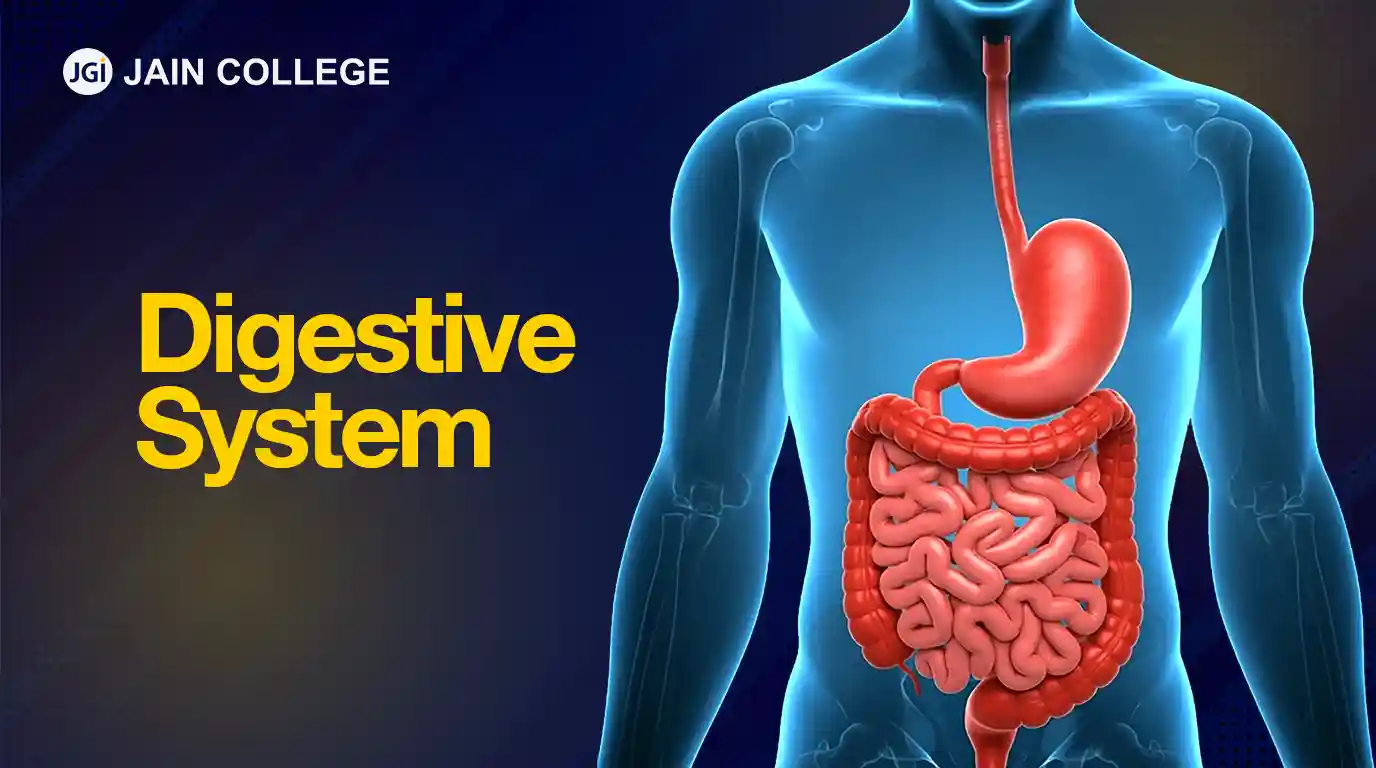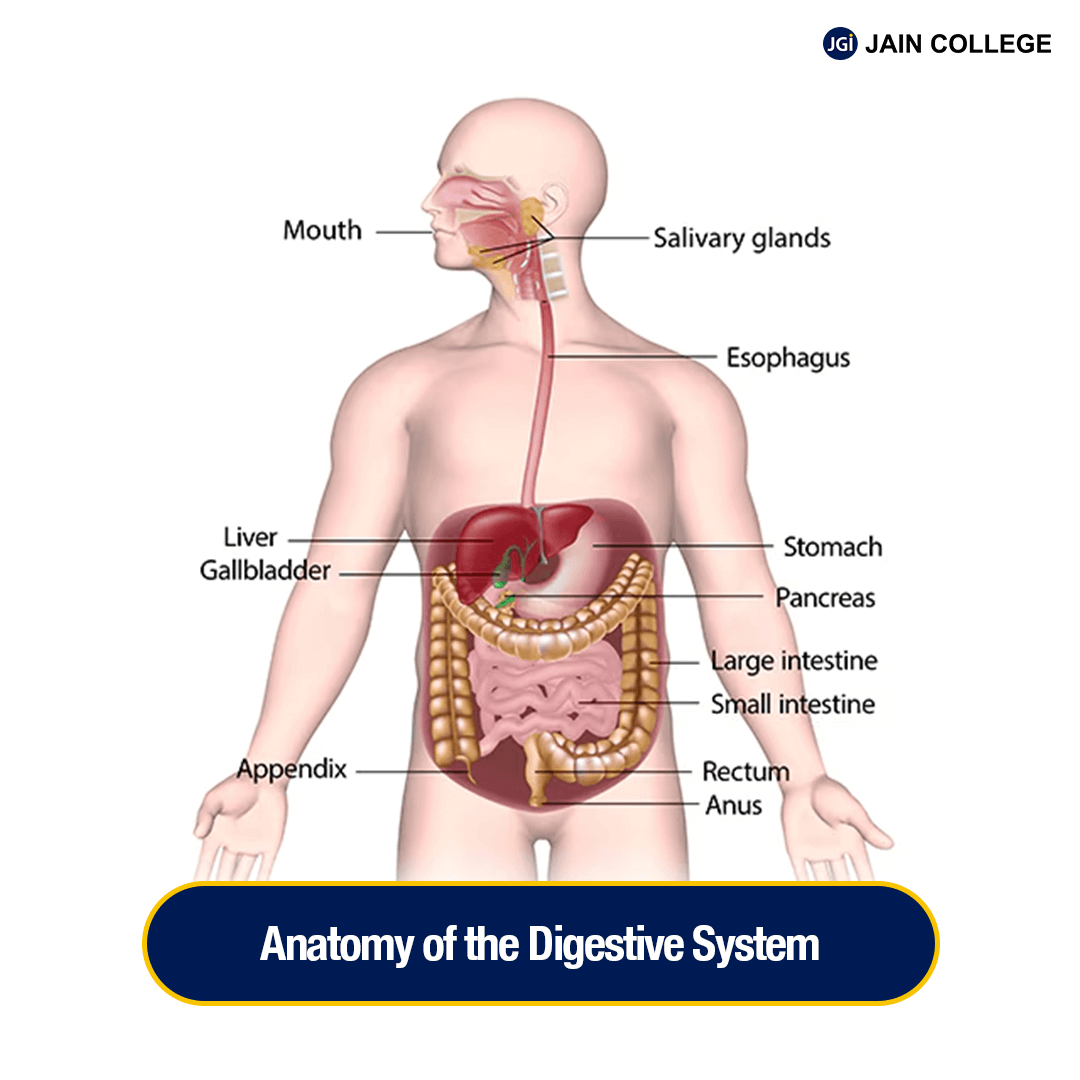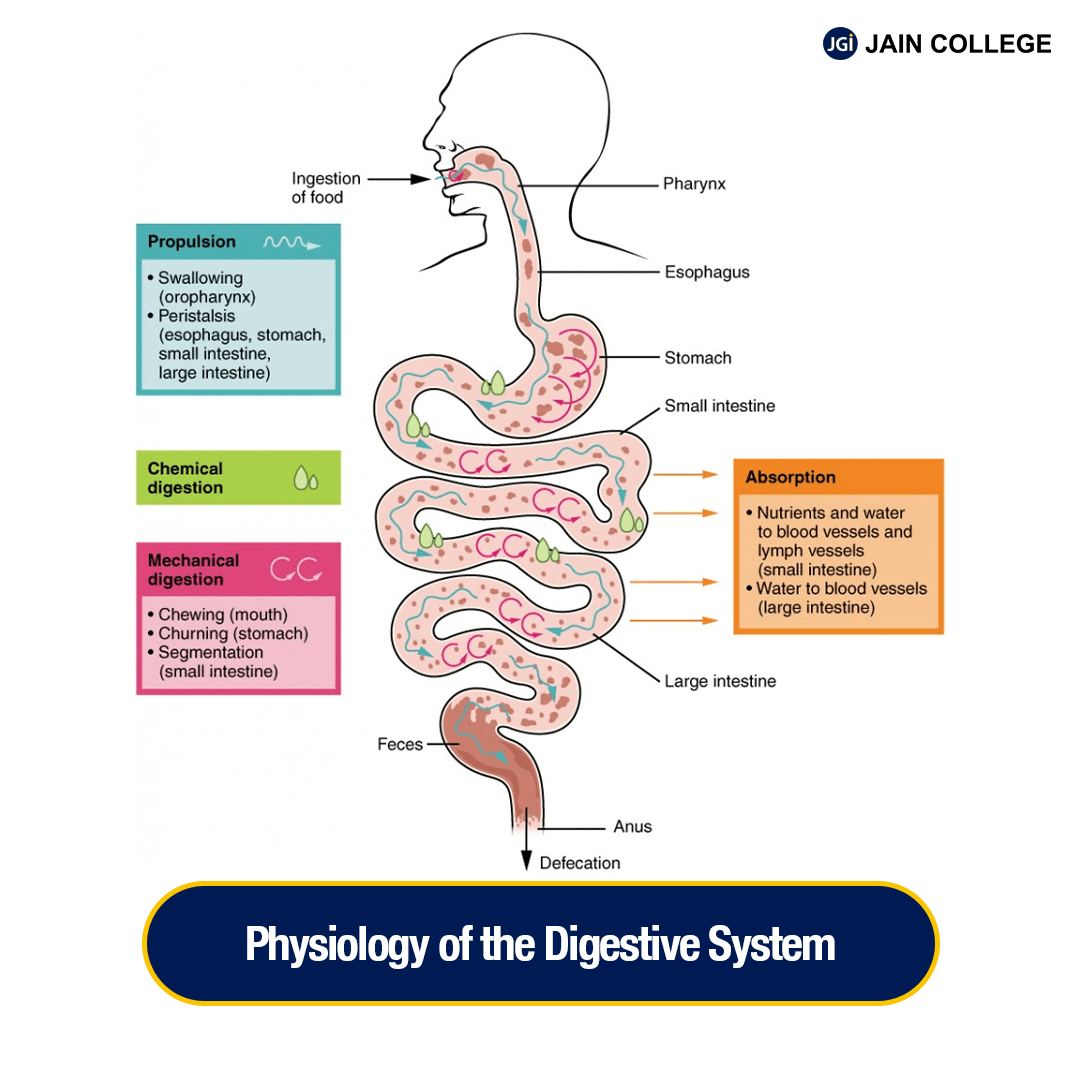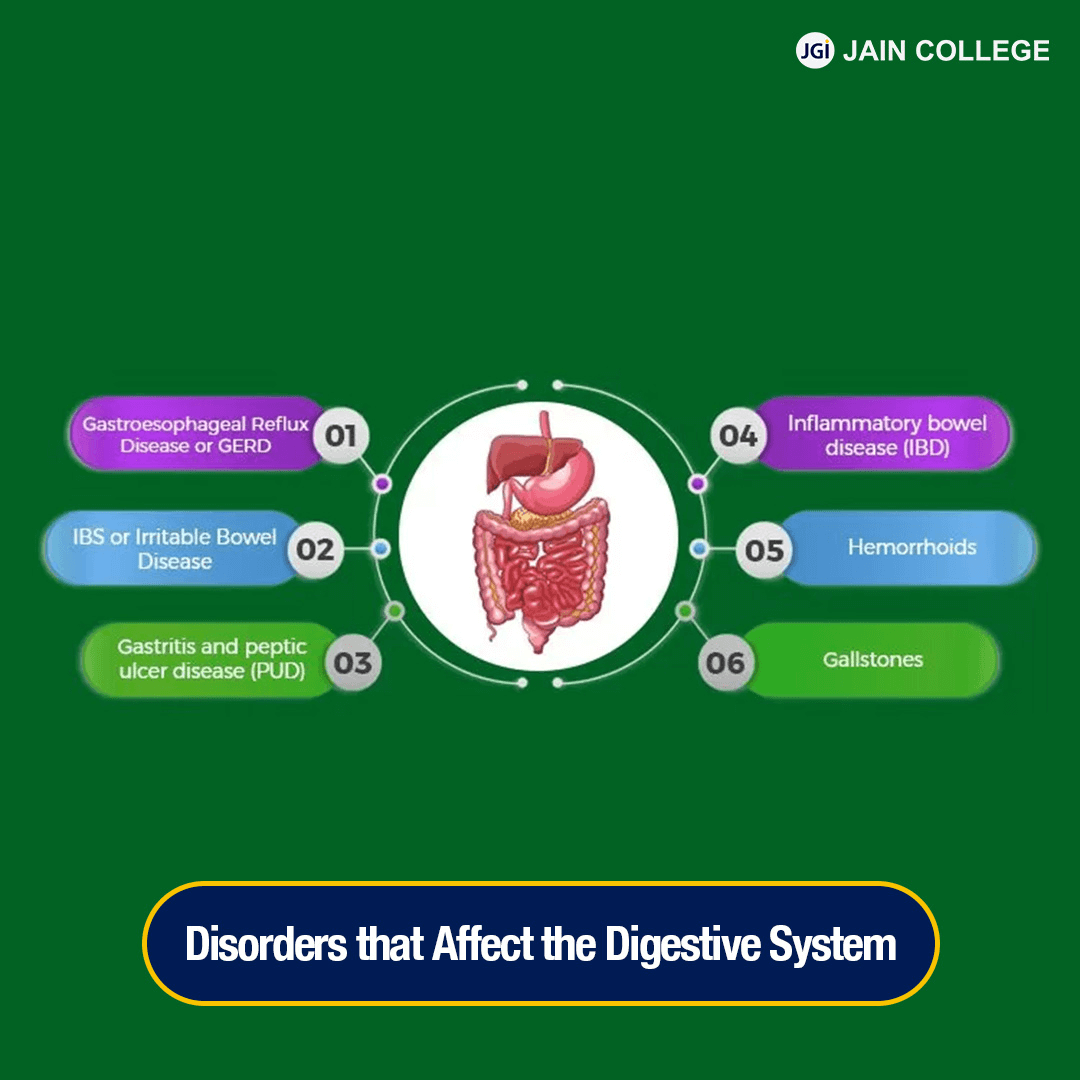
Have you ever thought about what happens to the food we eat?
We chew it, swallow it, and then… what?
That’s where the digestive system comes in!
The digestive system is like a food factory functioning inside our body, which breaks down everything we eat into energy and nutrients that keep us strong and healthy.
The digestive system is composed of a group of organs that work together to digest and absorb nutrients from the food you eat. Digestion is a complicated process, and conditions and disorders can disrupt that process.
In this article, let us explore in detail the Digestive system, its Anatomy, Physiology and some interesting facts.
The digestive system breaks down the food we eat into tiny parts to give us fuel and the nutrients we need to live. As food breaks down, we get amino acids from protein, simple sugars from starches, and fatty acids and glycerol from fats.
The digestive system process starts in our mouth when we chew and ends when our body gets rid of the waste it doesn’t need.
Our stomach, intestines, and other digestive system organs all work together to ensure that we get the most out of our food.
The accessory organs include the teeth, tongue, and glandular organs such as the salivary glands, liver, gallbladder, and pancreas.
Without the digestive system, we would not have the strength to walk, play, study, or even think properly!
It is one of the most important systems in our bodies, making sure we have the fuel we need for every part of our day.
The digestive system consists of the many parts of the body that work together to turn food and liquids into the building blocks and fuel that the body needs.
The main parts of your digestive system are the gastrointestinal (GI) tract and the biliary tract:

The gastrointestinal (GI) tract is a long tube that runs from our mouth to the anus. The GI tract would measure up to 30 feet (9 meters)
The gastrointestinal (GI) tract comprises:
Mouth: The process of digestion begins in our mouth
Oesophagus: This is a tube present in the centre of our chest, behind the windpipe (trachea) and in front of the spine
Stomach: Our stomach resides in the upper abdomen on the left side of our body
Small intestine: This 22-foot-long muscular tube is the longest part of our gastrointestinal tract. It coils up in your lower abdomen and curves around your pancreas
Large intestine: The last step in the digestive system process is carried out by the large intestine. It comprises the colon, rectum and anus
The biliary tract resides in our upper abdomen (belly). It comprises the organs that support the digestion process by delivering bile and enzymes that help our small intestine break down food.
The biliary tract includes:
Bile ducts: The bile ducts are present both inside and outside your liver and are connected to the gallbladder.
Gallbladder: The gallbladder, located below our liver on the right side of the body
Liver: The liver is both a vital organ and the largest gland in the human body, located on the right side of our body under the ribs.
Pancreas: The vital gland in the abdomen plays a key role in both digestion and blood sugar regulation, producing enzymes for digestion and hormones like insulin and glucagon. It is present behind the stomach and in front of the spine on the right side of the body.
Digestive systems perform multiple functions behind the scenes, which ensure our body gets all the nutrients it needs from the food we eat.
The Human Digestive system follows a step-by-step process to convert food into energy.
Digestion is the process of mechanically and enzymatically breaking down food into substances for absorption into the bloodstream. This process all begins from the moment we put a piece of food in our mouth or sip a drink.

Here is the complete step-by-step process of Digestion:
Step 1:
Our mouth chews the food into smaller pieces while saliva helps break it down
Step 2:
Then, we swallow, and the food slides down the oesophagus like a water slide, straight into the stomach
Step 3:
Here, strong acids and enzymes mix everything into a soupy liquid, making it easier to digest
Step 4:
Next, the food moves to the small intestine, where most of the nutrients are absorbed into the blood
Step 5:
This is where our body takes in vitamins, proteins, and everything else we need to stay strong and healthy
Step 6:
The leftover parts travel to the large intestine, which absorbs water and gets rid of waste
Step 7:
Finally, whatever isn’t needed is removed from the body
Thus, the digestive system plays an important role in our life process by converting food into energy. The obtained energy is utilised by our body cells to walk, talk, read, run, play, think, grow and do other metabolic activities.
The process of digestion all starts in the mouth and continues as food travels down a long tube called the oesophagus, like a slide that leads straight to the stomach.
From the stomach, the mushy liquid moves into the small intestine, where the real magic happens. Our body absorbs all the nutrients it needs from food!
Finally, the waste exits through the rectum and the anus.
The below tabular column explains the complete process of how the Human Digestive System functions:
| Digestive Organ | Function |
Mouth | Food is masticated, tasted, and mixed with digestive fluids or salivaWith the help of saliva, starch present in the food particles is broken down |
| Esophagus | Moves food and liquid through the gastrointestinal tract and mixes the contents within each organ |
Stomach | The Upper muscle in the stomach relaxes to let food enter, and the lower muscle mixes food with digestive juiceWith the help of stomach acid and digestive enzymes, proteins present in the food particles are broken down |
Small Intestine | The muscles of the small intestine mix food with digestive juices from the pancreas, liver, and intestine, and push the mixture forward for further digestionWith the help of the small intestine and digestive juice, starches, proteins, and carbohydrates present in the food particles are broken down |
Pancreas | The pancreas functions by delivering the digestive juice to the small intestine through small tubes called ducts.With the help of enzymes present in the digestive juice, carbohydrates, fats, and proteins present in the food particles are broken down |
Liver | The liver functions in the digestive system by producing a digestive juice called bile that helps digest fats and some vitaminsBile ducts carry bile from your liver to your gallbladder for storage, or to the small intestine for use |
Gallbladder | The gallbladder stores bile between mealsWhen we eat, our gallbladder squeezes bile through the bile ducts into our small intestine |
Large Intestine | In our large intestine, more water moves from our GI tract into our bloodstream Bacteria in our large intestine help in the breakdown of remaining nutrients and make vitamin K Waste products of digestion, including food particles that are still too large, become stool |
Sometimes, our digestive system does not function as smoothly as it should, and that can lead to disorders. The digestive system diseases are mainly caused by eating unhealthy food, stress, and not drinking enough water can make these problems worse.

Some of these conditions and disorders of the Digestive System include:
GERD - Gastroesophageal Reflux Disease:
It is a condition in which the stomach contents leak backwards from the stomach into the oesophagus (food pipe). Over time, GERD can damage your oesophagus
Irritable bowel syndrome (IBS):
This disorder can cause stomach pain, bloating, and irregular digestion
PUD - Peptic Ulcer Disease:
It is also called Gastritis and Peptic Ulcer Disease
PUD is a condition which is characterised by discontinuation in the inner lining of the gastrointestinal (GI) tract and is caused because of gastric acid secretion or pepsin. This condition usually occurs in the stomach and proximal duodenum, which may also extend into the muscularis propria layer of the gastric epithelium
Ulcers:
It is a more serious condition, which causes painful sores in the stomach lining
Diarrhoea:
It is the opposite of constipation, causing frequent and watery bowel movements
Constipation:
It is another issue, making it hard to pass waste
IBD - Inflammatory Bowel Disease:
It is the conditions that cause swelling and inflammation of the tissues in the digestive tract. The most common types of IBD include chronic diseases and ulcerative colitis
Hemorrhoids
Haemorrhoids are swollen around the anus or the lower part of your rectum. Haemorrhoids is also called piles, are similar to varicose veins. There are two types of haemorrhoids:
Gallstones
Gallstones are hardened deposits of bile that can form in your gallbladder. The presence of too much cholesterol, bile salts, or bilirubin (bile pigment) can cause gallstones
Indigestion:
It is a common problem which happens when our stomach struggles to break down food, making us feel bloated or uncomfortable. Then there’s acid reflux, when stomach acid travels back up the oesophagus, causing a burning feeling in the chest (also called heartburn)
Thus, taking care of our digestive system by eating balanced meals, drinking water, and exercising can help prevent these digestive system diseases. After all, a happy digestive system means a happy and healthy body!
The human digestive system includes a series of structures, processes and organs through which food and liquids are broken down during the process. This system functions together to convert or break down the food particles into nutrients, which our body needs to function.
Here are some cool and surprising facts about it!
Fact No. 1:
It starts before you even eat! Just thinking about food can make your mouth water, getting your digestive system ready for action
Fact No. 2:
The acid in our stomach is powerful enough to break down food and even kill bacteria
Fact No. 3:
Our stomach has a special lining which protects itself from the strong acids present in our stomach
Fact No. 4:
The small intestine is around 22 feet long. If it is stretched out, it would be longer than most cars
Fact No. 5:
The food from the mouth is passed through the muscles in our esophagus, which pushes food down into our stomach, even if you are upside down
Fact No. 6:
The large intestine functions in the digestive system by keeping our body hydrated by recycling water by absorbing the extra water from food
Fact No. 7:
Our digestive system never stops working. Even when we are sleeping, our digestive system are busy digesting the food we consume during the day
Fact No. 8:
It takes 4 to 72 hours to digest the food. It can also depend on what we eat
Fact No. 9:
The food we eat and the liquids we drink travel through several organs that make up the digestive tract. These organs include the mouth, pharynx (throat), oesophagus, stomach, small intestine, large intestine, rectum, and anus
These were some interesting facts about the human digestive system.
Thus, taking care of our digestive system by eating healthy foods, drinking water, and staying active helps keep it functioning smoothly.
The digestive system does an excellent job of keeping us energised and healthy. From the moment we take a bite to the final step of digestion, there is a constant flow of activity in our bodies. So, the next time you enjoy your favourite meal, remember to thank your digestive system for all its hard work!
Join JAIN College for top-notch Science, Commerce, and Arts programmes. Secure your path to success today!
Digestion is important because your body needs nutrients from food and drink to work properly and stay healthy. Proteins, fats, carbohydrates, vitamins NIH external link, minerals NIH external link, and water are nutrients. Your digestive system breaks nutrients into parts small enough for your body to absorb and use for energy, growth, and cell repair.
Surprisingly, yes! If someone’s stomach is removed due to medical reasons, their intestines can still digest food, but in a different way.
It is the system in our body that breaks down food and turns it into energy and nutrients to keep us healthy and strong.
The biliary tract is the network of organs and ducts which play a major role in producing, storing and releasing fluids called bile that aid in fat digestion, from the liver to the small intestine.
The GI - gastrointestinal tract is a series of hollow organs that connect to digest and move food through your body. It includes your mouth, oesophagus, stomach, small intestine and large intestine.
The accessory organs of the digestive system include the teeth, tongue, and glandular organs such as the salivary glands, liver, gallbladder, and pancreas.
The biliary tract mainly comprises the bile ducts, gallbladder, liver, pancreas and associated structures that are involved in the production and transportation of bile.
Digestion can take anywhere from 24 to 72 hours, depending on what you eat. Fatty foods take longer, while fruits and veggies digest faster!
That rumbling sound happens when our stomach and intestines move air and food around—usually when we are hungry!
If the digestive system stops working properly, problems like indigestion, constipation, diarrhoea, or acid reflux can occur. Thus, eating healthy food and drinking plenty of water helps keep it running smoothly.
Eat fibre-rich foods (like fruits and veggies), drink lots of water, exercise, and avoid too much junk food. A happy digestive system means a happy body!

JAIN PU College, a part of the renowned JGI Group, is committed to empowering students with quality education.
Beyond academics, the college ensures its online content reflects the same standard of excellence. Every blog and article is meticulously vetted and proofread by subject matter experts to ensure accuracy, relevance, and clarity. From insightful educational topics to engaging discussions, JAIN PU College's content is crafted to inform, inspire, and add value to its readers, reflecting the institution's commitment to intellectual growth and innovation.
View all Blogs